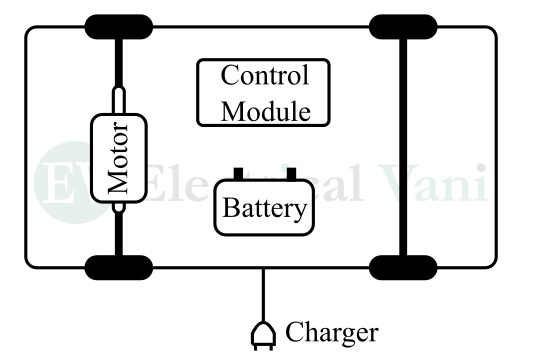In this article, we will discuss the basics of battery electric vehicles (BEVs) along with their advantages and disadvantages. As we know, an electric vehicle is a mode of transportation that utilizes electricity to operate. An electric vehicle can be a two-wheeler, three-wheeler, or four-wheeler vehicle. The main components of an electric vehicle include a battery (source of electrical energy), an electric motor (source of mechanical energy), and a vehicle architecture. The battery provides the necessary electrical energy required for the working of the electric vehicle, the electric motor converts the battery’s electricity into mechanical energy and drives the wheels of the vehicle.

What is a Battery Electric Vehicle (BEV)?
In a battery electric vehicle, there is no internal combustion engine, instead, it completely runs using electric motors and battery electricity. Therefore, these electric vehicles are also known as all-electric vehicles.
In the case of battery electric vehicles, the electrical energy required to operate the electric motors is stored in a large battery pack. The battery pack must be charged from an external source of electricity by plugging it.
However, the battery pack of the battery electric vehicles also charges through a process called regenerative braking. In this process, the energy is recovered and utilized to recharge the batteries during the braking of the vehicle.
The basic block diagram of a battery-electric vehicle is shown in the following figure.

Main Components of Battery Electric Vehicle
The following are the main components of a battery-electric vehicle:
- Electric Motor – The electric motor converts the electrical energy into mechanical energy and drives the wheels of the vehicle.
- Battery Pack – The battery pack is a group of multiple batteries connected together to store a large amount of electricity required for the operation of the vehicle.
- Control Module – It consists of a whole electronic system and controls the flow of electrical energy from the battery to the motor.
Working of Battery Electric Vehicle
When a vehicle is started, the electric energy starts flowing from the battery pack to the electric motor, where the motor rotates the wheels.
When the accelerator pedal is pressed, a control signal is given to the controller, the controller then sends a signal to regulate the flow of electricity from the battery to the motor to adjust the speed of the vehicle.
When the brakes are applied, the electric motor’s speed starts decreasing and the motor starts acting like a generator. The electrical energy generated during the braking process (regenerative braking) is transferred back to the battery pack to recharge it.
This is how a battery electric vehicle works by utilizing the electricity stored in a battery pack and an electric motor.
Charging of Battery Electric Vehicle
The battery of the battery electric vehicles is recharged by the following two methods:
- By plugging-in into an external source of electricity.
- Through regenerative braking during braking of the vehicle.
A typical battery electric vehicle takes around 7 to 8 hours to get fully charged. However, this time depends on the capacity of the battery pack and many other factors.
Advantages of Battery Electric Vehicles
The following are some key benefits of battery-electric vehicles:
- Battery electric vehicles cause no emissions while running.
- Battery electric vehicles have a silent operation.
- There is no need for gas or oil changes in a battery electric vehicle.
- Battery electric vehicles can be charged at home conveniently.
- Battery electric vehicles provide fast and smooth acceleration and deceleration.
- The operational cost of a battery electric vehicle is very low.
- Battery electric vehicles provide a high and instant torque, even at slow running speeds.
Disadvantages of Battery Electric Vehicles
Although, a battery electric vehicle has several advantages in terms of pollution and operation cost. It also has several disadvantages as well. Some very common disadvantages of battery electric vehicles are listed below:
- Battery electric vehicles provide a limited and shorter driving range as compared to petrol vehicles.
- The initial cost of a battery electric vehicle is more than that of a comparable traditional ICE vehicle.
- The charging stations for charging battery electric vehicles are limited and not widespread like fuel stations.
- A battery electric vehicle takes a very long period to get fully charged.
- In battery electric vehicles, the performance and capacity of the battery pack degrades over time. That needs to be replaced and is quite expensive.
- Battery electric vehicles come in a limited variety of models.
- The operation of battery electric vehicles is completely dependent on the electric power grid and the availability of electricity. Hence, battery electric vehicles are not suitable for regions, where electricity supply is limited.
Conclusion
In this detailed article on “battery electric vehicles (BEVs)”, we have discussed their construction, working, advantages, and disadvantages. A battery electric vehicle is a type of electric vehicle whose operation completely depends on electricity. In a battery electric vehicle, the electrical energy is stored in a large battery pack and this electricity is utilized to power an electric motor that in turn drives the wheels of the vehicle.
If you have any questions related to this concept, kindly please write in the comment box. I will answer shortly.